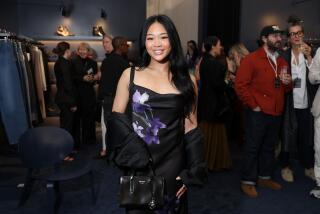DESIGNERS : Going Solo
For Holly Sharp, Biya Ramar and Lee Saelee--three young California designers with their own companies--happiness is a new boutique.
Within the past year, each has opened a first store, embraced life in the retail lane and earned high marks from the experts for making the right move at the right time.
âThat is the way to go. That is the wave of the future,â says designer Betsey Johnson who opened her first store 12 years ago in Soho, N.Y., and recently opened store No. 14 in Santa Monica.
âIt means you have total spiritual, visual and business control. You get that markup that Bloomingdaleâs gets. And itâs much more secure than wholesale. They cancel you out if youâre one day late (on delivery). They love you, they hate you. But in your own store you find your own true-blue customers. â
Some analysts donât agree. Alan Millstein, publisher of Fashion Network Report, a newsletter for retailers and manufacturers, argues: âBecause of lack of support from major retailers, there is little or no shelf space left for most of the innovative young designers in this country. So out of desperation, theyâre opening shops. Theyâre better off sticking to the wholesale business rather than a business that is chancy at best.â
But Harry Bernard, executive vice president of Colton Bernard, apparel marketing consultants, is more optimistic: âI think the object of opening your own store is a correct one--if you understand retailing and if you recognize that the store is to be your showcase and treat it as such.â
Holly Sharp
âWhen I chose this career over commercial art 10 years ago, I chose it from an artistâs point of view,â says Sharp, who opened her Laguna Beach boutique in April with husband-business partner Michael. âI had a vision of a designer in a white frock who works with the customer. By accident we got thrown into a huge wholesale business. This is like two steps back, working with my hands and the customer, back to when I was a kid, back to when I thought fashion was so magical.â
Her â40s-inspired dress, blouse and sportswear lines are carried by Henri Bendel, Barneys, Saks Fifth Avenue, Nordstrom, Bullockâs and specialty stores nationwide. Sharp is so frustrated with the way some stores treat her merchandise--garments crammed on racks or lying on the floor--she goes in and rearranges it on the racks.
But in her bright, airy boutique the problem doesnât exist. Her entire collection--priced $30 to $200--is displayed âmy way,â she says. She moves the furniture around weekly, and she sells anything that strikes her fancy--including the furniture.
There are antiques she has been collecting for years, down-filled pillows covered in her own fabric, her own potpourri and romantic, feminine accessories she commissions from designer friends, such as milliner Elizabeth Marcel.
Using the boutique as a showcase, she recently invited Saks executives to see how she displays her work. She also treats it as a testing ground, supplying it with special garments--such as long linen dresses with antique bone buttons--âthat maybe are not appropriate for wholesale but are appropriate here.â On Wednesdays she goes to the store to touch base with customers.
ââIâm having fun,â she says. âIt feels wonderful to design a product and put it in the bag of the person who is going to wear it.â
Biya Ramar
It is a similar story for Ramar, 34, designer of Rated R by Biya. Her sensuous sportswear is carried in stores such as Ron Ross, Henri Bendel, Macyâs and Ann Taylor. But in Eclectia, the Beverly Boulevard boutique she operates with Robin Foster, the designer says: âI can play with more ideas and make them few-of-a-kind, instead of mass producing.â
Ramar and Foster turned the interior of an old Spanish-style building into an elegant salon. Open since October, the store is a showcase for both Rated R and Ramarâs limited-edition âideas.â Prices range from $85 to $210.
The collection includes handmade chenille sweaters and long, understated sleeveless sheaths in Japanese silk-Jacquards.
During her nightly visits to the store, located on a quiet block near the Beverly Center, Ramar says, âI get ideas. It gives me a different perspective.
âI believe the customer spends more, because she gets a sense of the whole collection. She knows what she can wear with what. Maybe (the major department stores) will buy a jacket and a skirt I didnât have in mind as a set. Or they will go very conservative and buy the basic outfits and not even try something different. The store gives me an opportunity to show all the ideas and let the customer decide.â
Lee Saelee
At Saeleeâs high-tech boutique on Main Street in Santa Monica, customers make their selections from three collections and a permanent sale rack.
The designer offers sexy, sophisticated suit separates and dresses that are carried by stores such as Bullockâs, Nordstrom and Macyâs. Prices run from $150 to $700. Signatures, an equally sexy, dressy line made in less expensive fabrics, is priced $80 to $225.
An exclusive store collection, priced $90 to $275, allows the designer to play with special fabrics and unusual takes on trends.
Saelee, 30, who opened the boutique in April with Tony Lawty, spends weekends at the store. Retail is âa chance to learn and to actually have contact with the woman who is wearing my clothes.â
There have been no complaints from his wholesale accounts, he says, âbecause to have a store like this adds prestige to the name.â And he now has the kind of exposure every designer dreams of: âWeâre always in the window. We donât have to wait our turn.â






